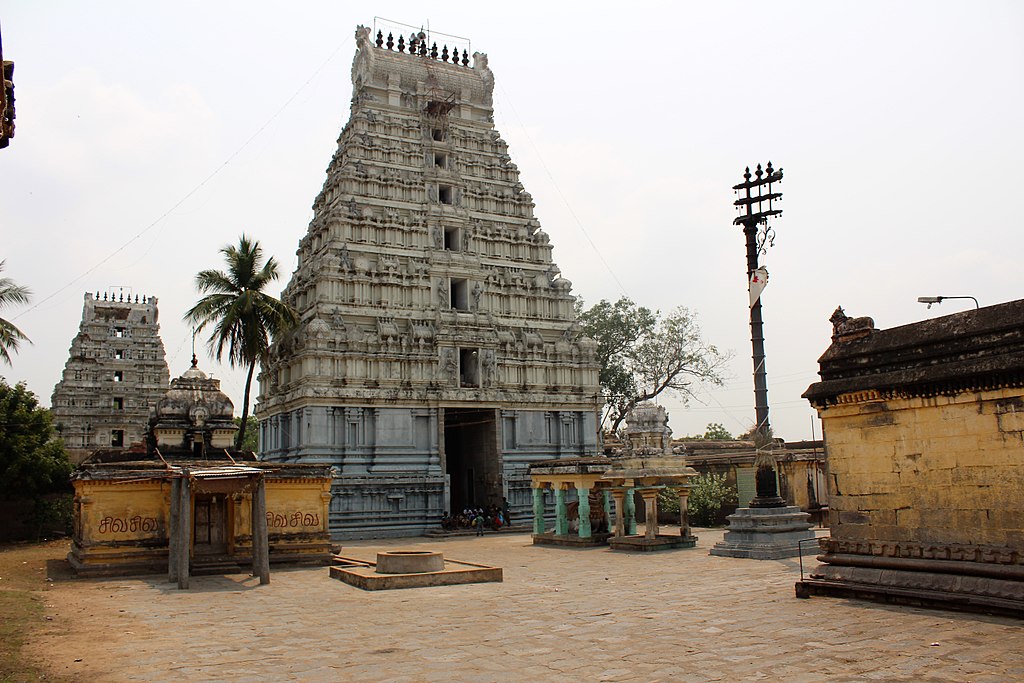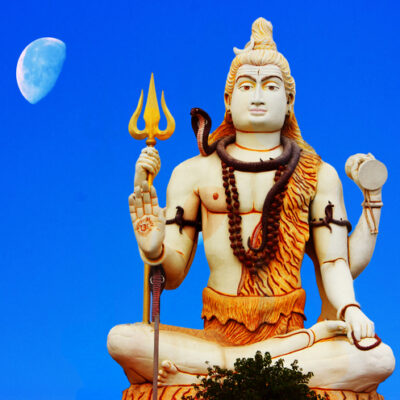Tiruvamathur Sri Abirameswarar Temple, Villupuram

Address
Tiruvamathur Sri Abirameswarar Temple, Thiruvamathur Post, Villupuram Circle, Villupuram District – 605 402. Tele: +91- 4146-223 379, 98430 66252.
Diety
Sri Abirameswarar, Sri Azhakia Nathar Amman: Sri Muthambigai, Sri Azhakia Nayagi
Introduction
Abirameswarar Temple (also called Thiruvamathur Temple) is a Hindu temple dedicated to the deity Shiva, located in thiruvamaathur, a village in Viluppuram district in the South Indian state of Tamil Nadu. Shiva is worshiped as Abirameswarar, and is represented by the lingam. His consort Parvati is depicted as Manonmani Amman. The temple is located on the Chennai – Villupuram highway. The presiding deity is revered in the 7th century Tamil Saiva canonical work, the Tevaram, written by Tamil saint poets known as the nayanmars and classified as Paadal Petra Sthalam. The temple complex covers an area of two acres and all its shrines are enclosed with concentric rectangular walls. The temple has a number of shrines, with those of Abirameswarar being the most prominent. There is a temple opposite to the premises that houses the shrine of Muthamman, the consort of Abirameswarar. Theertham (Holy water): Ambalam Poompoigai (tank); Dhanda Theertham (well); Pampai/ Kadamba River Sthala Vriksham (Sacred Tree): Vanni tree
Puranic Significance
Thiruvamathur is located on the banks of the Pampa river, a tributary of the Pennai river. The historical names of this place are – Gomathrupuram, Gomatheeswaram and Gomathupuram. This temple was originally built by the Pallava rulers. Later on, the Cholas made several endowments. This is evident from the stone inscriptions available here. At a later date, Achutha Deva Pallavar is believed to have renovated this temple. There is an idol of Achutha Deva Pallavar here. In this temple, there are stone inscriptions that document the histories of 26 kings from 955 to 1584 AD. The important kings among them are Rajaraja Cholan-I, Rajendra Cholan-I, Rajathi Rajan-I, Kulothungan-I, Vikramathithan, Sadaya Verman, Vikrama Pandian and Krishnadeva Rayar. The stone inscriptions also reveal that a Chola king sanctioned a grant that helped several blind students learn the devaram hymns and sing them in the temples. In ancient times this place was densely covered with Vanni trees. It is believed that at that time the cows did not have any horns and were frequently tormented by other wild animals. It is believed that the cows went to Nandhi (Lord Shiva’s bull mount) to seek protection. Nandhi advised them to come to this place and worship the lord. Nandhi, Kamadenu (the divine cow) and other cows came to this place and worshiped the lord. Pleased with their penance, Lord Shiva blessed them with horns to protect themselves. The name of this place “Thiru Amathur” is derived from “Thiru Aa Matha Vur” – “Aa” means cow, “Matha” means mother, “Vur” means village in Tamil and “Thiru” is a respectful prefix. For this reason, this place is revered as the “parental house” of cows. According to Hindu mythology, all gods including Lords Shiva, Mahavishnu, Brahma, Goddess Parvathi, Lakshmi and Saraswathi and all Devars reside in the body of the cow. It is believed that the divine cow, Kamadenu along with other cows worshiped the main deity here by pouring their milk on the lingam. The marks of the cow’s hoof and rivulets due to the pouring of milk can be seen on the lingam. There is a place inside Goddess Muthambikai’s temple called the “Thiruvattaparai”. There is a Shivalingam in Thiruvattaparai which is very famous. There is a small hall (Mandapam) called “Sathya Palakai” (literally translated as “a place to make promises”) in the southwest corner. According to legend, sitting at this spot, Lord Ram alongwith Hanuman entered into an alliance with Sukrivan to fight and kill Ravana. To cleanse himself of the sins accrued by killing Ravana, Lord Ram worshiped Lord Shiva here. There is a well inside this temple called “Dhanda Theertham” which is believed to have been created by Lord Ram. The lord’s name “Sri Abhirameswarar” is derived from the believe that Lord Ram worshiped Lord Shiva here. “Abhi” means affectionately and “Eswarar” is a respectful way of referring Lord Shiva. In his hymn of this temple, Saint Thirunavukkarasar had mentioned about Lord Ram’s affection towards the lord of this temple. Even today, people who have been wrongly accused of some crime come to the “Sathya Palakai” at the “Thiru Vattaparai” and make pledges of their innocence. It is strongly believed that if someone makes a false promise at this place, they will be severely punished by the Goddess. The legend is that Goddess Muthambikai once punished a man by having him bit by a snake because he had cheated his younger brother and made a false promise at this place. To signify this event, the tail portion of a snake adorns the Goddess’s chest. This can be seen during abishekam.It is believed that once Sage Brungi Muni went to Kailash to worship Lord Shiva but found that the lord was with Goddess Parvathi. The sage was such an ardant devotee of Lord Shiva that he refused to worship anyone else. So, he took the form of a fly and went around Lord Shiva and worshiped him. When Goddess Parvathi came to know that the sage had ignored her, she cursed him. Her curse turned the sage into a tree. The sage realized his mistake and worshiped both of them and sought pardon. It is believed that he performed penance in this temple and got absolution. The Vanni tree, which is the sacred tree of this temple, signifies the fact that sage Brungi was turned into a tree by Goddess Parvathy’s curse. It is also believed that Lord Murugan worshiped Lord Shiva and Goddess Parvathi here and was blessed with the “Vel” (spear) before going to fight with demon Surapadman. Another legend associated with this temple is that of poets Ilam Surya and Mudu Surya (Ilam means junior and Mudu means senior in Tamil). One of them was blind and the other was lame. They travelled from one town to another singing the glory of Lord Shiva. While singing about the lord of this temple, “Thiruvamathur Kalambakam”, they made a small mistake – they said that this temple is on the western side of the river Pampa although it is on the eastern side. Some of the people who had assembled in the temple started teasing them. The lord came to their rescue and caused a heavy downpour. It rained so much that the river changed its course overnight. When the people reassembled the temple the next day, there was no need for the poets to correct their verse – the temple was now on the western side of the river. It is believed that Goddess Parvathy, Vinayakar, Murugan, sages Agasthiyar, Vashistar, Durvasar, Brungi, Parasarar, viswamithar, Veda Vyasar, Roma Rishi, Narathar, Mathanga Muni, Ashta Vasus, Nandhi and Kamadenu have worshiped the lord here. Also, Lord Ram, Sita, Lakshman and Hanuman have worshiped Lord Shiva here.
Beliefs
The shrines of Lord Shiva and the Goddess Parvathi are on either side of the road and are facing each other. There is a hole in the compound walls of the two temples through which the lord and goddess can see each other. Couples come to this place and worship the lord in the hope that marital discord will be removed and their relationships will improve. People pray to Goddess Muthambikai for removal of obstacles in their marriage proposals. Those seeking “santhana prapthi” (child boon) can pray to the Goddess here.
Special Features
This is one of the 276 Devara Paadal Petra Shiva Sthalams and 21st Shiva Sthalam in Nadu Naadu. Lord Shiva in this temple is a Swayambumurthi (self-manifested). Lord Shiva’s idol has the impression of a hoof at the top. There are multiple rivulet markings which signify that this lord was worshiped with milk that flowed from udders of cows. Inscribed on the chest of Goddess Muthambikai’s idol here is a small piece of what looks like a snake’s tail. There are two separate temples here. Goddess Muthambikai’s temple is right in front of Lord Shiva’s temple. Lord Shiva’s temple has a 7-tiered main tower (Rajagopuram) with 2 corridors while the goddess’s temple has a 5-tiered main tower with a single corridor. This is one of the 44 Paadal petra sthalams where the “Moovar” (the three saints – Saint Thirugnanasambanthar, Saint Thirunavukarasar (Appar) and Saint Sundaramurthy (Sundarar) had rendered their Pathigams. Vannacharabam Sri Dandapani Swamigal lived in this place. The first “Kaumara Madam” was established here. Lord Shiva, a Swayambumurthy, is facing east and Goddess Muthambikai is facing west. There is a “Sri Chakra” in the goddess’s shrine is believed to have been installed by Sri Adi Sankara. Other than the shrines of Lord Shiva and Goddess Parvathy, shrines and idols of lords Sidhi Vinayakar, Murugan, Sivapujai Vinayakar, Natarajar, Dakshinamurthy, Lingodhbavar, Brahma, Durga, Bikshandavar, Sahasralingam, Lord Ram, Goddess Lakshmi, Sapthamadhakkal, Naalvar, 63 Nayanmars, Chandikeswarar, Bhairavar and the Navagraham can be seen in the corridors. The corridor also houses the “Ashta lingams”. The eight lingams that constitutes the Ashta lingams are – Sri Abirameswarar (main deity), Esanya Lingeswarar, Kasi Viswanathar, Arunachaleswarar, Kubera Lingam, Vayu Lingam, Hanuman Lingam and Sattanathar.
Festivals
10-day Brahmotsavam in the Tamil month of Panguni (Mar-Apr) is an important festival celebrated here. Other important festivals celebrated in this temple are – Shivrathri in the Tamil month of Masi (Feb-Mar), Aadi Pooram in the Tamil month of Aadi (July-Aug), Vinayakar Chaturthi in the Tamil month of Aavani (Aug-Sept), Navrathri in the Tamil month of Purattasi (Sept-Oct) and Annabishekam in the Tamil month of Aippasi (Oct–Nov). Pradosham is also observed regularly.
Century/Period/Age
1000-2000 years old
Managed By
Hindu Religious and Charitable Endowments (HRCE)
Nearest Bus Station
Tiruvamathur
Nearest Railway Station
Villupuram
Nearest Airport
Chennai









